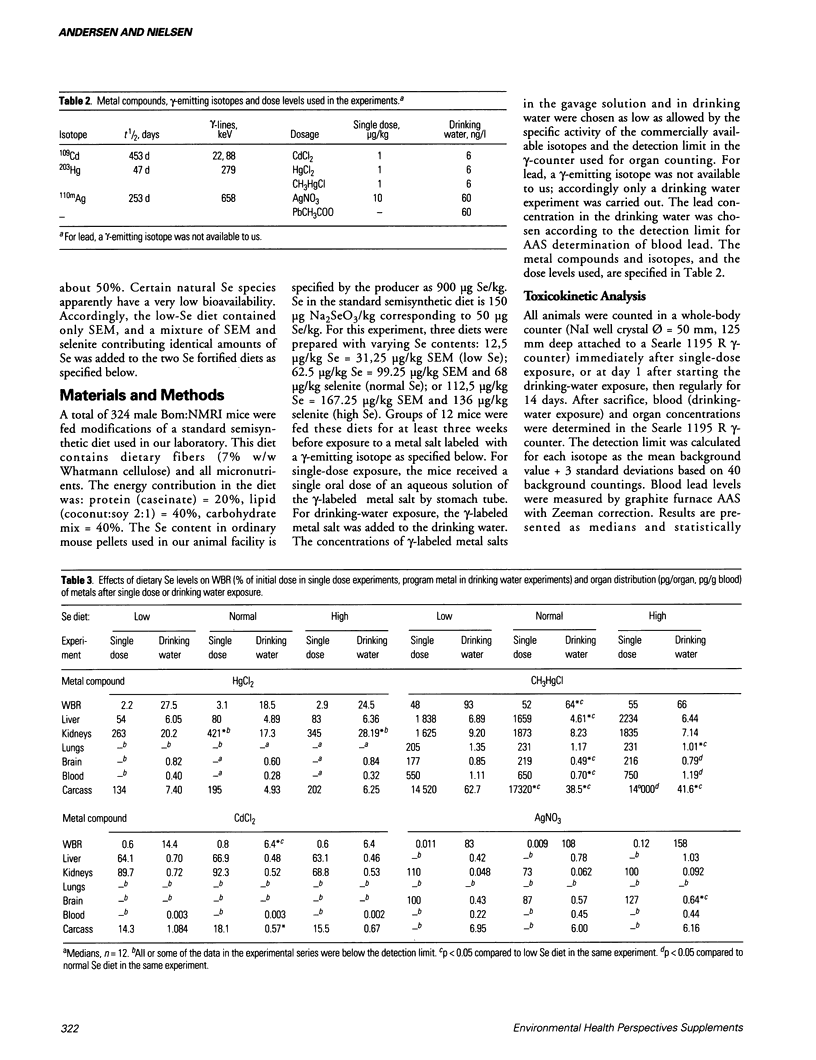Abstract
Classical experiments have demonstrated that Se compounds protect against the toxicity of several toxic metals in acute experiments with simultaneous parenteral administration of high doses of Se and the toxic metal. Blood and organ levels of the toxic metals were increased, conceivably due to formation of inert Se complexes. Less is known about effects of long-term Se status on the toxicokinetics of toxic metals. Possible Se interactions in toxic metal biokinetics should therefore be studied at Se levels ranging from those just sufficient to avoid Se deficiency and up to those believed to be optimum in relation to antioxidative and other beneficial effects of Se. The toxic-metal exposure levels investigated should be similar to those occurring in human populations that are not occupationally exposed. To study interactions between Se and toxic metals at ultralow exposure levels, mice were fed semisynthetic diets containing different levels of Se. The mice were given ultralow doses of metal salts either as a single oral dose by stomach tube or as prolonged exposure in the drinking water. Diets with high or normal Se levels slightly, but nonsignificantly increased the whole-body retention (WBR) of Hg++ and CH3Hg+ compared to a diet low in Se. The dietary Se level was, however, without effect on the WBR of Cd2+ and Ag2+ in single-dose experiments. During prolonged exposure, the diets fortified with Se increased the WBR of Ag2+, had no effect on WBR of Hg2+, and reduced the WBR of CH3Hg+ and Cd2+. During prolonged exposure, the diets fortified with Se reduced blood Hg++ while organ levels were unaltered.(ABSTRACT TRUNCATED AT 250 WORDS)
Full text
PDF



Selected References
These references are in PubMed. This may not be the complete list of references from this article.
- Chmielnicka J., Brzeźnicka E., Sniady A. Kidney concentrations and urinary excretion of mercury, zinc and copper following the administration of mercuric chloride and sodium selenite to rats. Arch Toxicol. 1986 May;59(1):16–20. doi: 10.1007/BF00263951. [DOI] [PubMed] [Google Scholar]
- Cikrt M., Bencko V. Mercury-selenium interaction: distribution and excretion of 203Hg2+ in rats after simultaneous administration of selenite or selenate. Toxicol Lett. 1989 Aug;48(2):159–164. doi: 10.1016/0378-4274(89)90170-7. [DOI] [PubMed] [Google Scholar]
- Factors influencing metabolism and toxicity of metals: a consensus report. Environ Health Perspect. 1978 Aug;25:3–41. doi: 10.1289/ehp.25-1637186. [DOI] [PMC free article] [PubMed] [Google Scholar]
- Kristensen P., Hansen J. C. Wholebody elimination of 75SeO2-3 and 203HgCl2 administered separately and simultaneously to mice. Toxicology. 1979 Feb;12(2):101–109. doi: 10.1016/0300-483x(79)90036-2. [DOI] [PubMed] [Google Scholar]
- Magos L., Clarkson T. W., Hudson A. R. Differences in the effects of selenite and biological selenium on the chemical form and distribution of mercury after the simultaneous administration of HgCl2 and selenium to rats. J Pharmacol Exp Ther. 1984 Feb;228(2):478–483. [PubMed] [Google Scholar]
- Nielsen J. B., Andersen O. A comparison of the effects of sodium selenite and seleno-L-methionine on disposition of orally administered mercuric chloride. J Trace Elem Electrolytes Health Dis. 1991 Dec;5(4):245–250. [PubMed] [Google Scholar]


